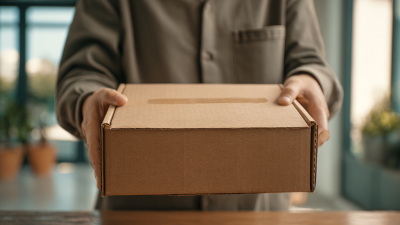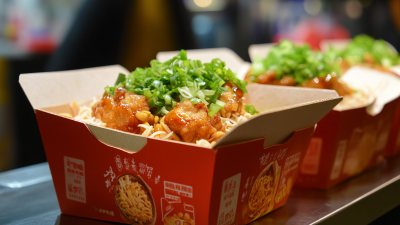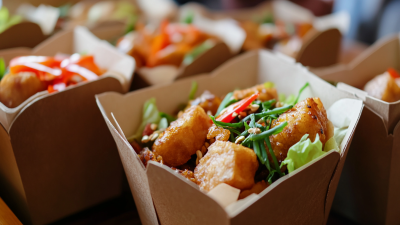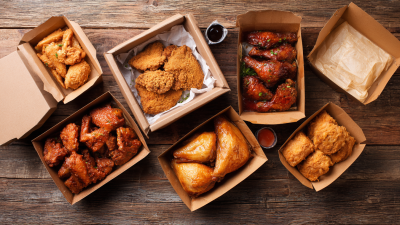Leave Your Message
In the rapidly evolving landscape of food packaging, innovative designs play a pivotal role in capturing consumer attention and enhancing the dining experience. As businesses strive to stand out in a crowded marketplace, the significance of creative and functional Food Packaging Boxes cannot be overstated. According to industry expert Dr. Emily Tran, a leading figure in sustainable packaging solutions, “The future of food packaging lies in designs that not only preserve quality but also engage consumers on an emotional level.” This perspective underlines the necessity for modern businesses to rethink their packaging strategies to create a lasting impression.
In this article, we will explore the top ten innovative Food Packaging Box designs that are redefining the industry. From eco-friendly materials to interactive features, these designs exemplify how functionality and aesthetics can blend seamlessly. As we delve into each example, we will highlight how these innovations not only meet consumer demands but also align with sustainable practices, paving the way for a more responsible future in food packaging. Join us as we showcase the creativity and ingenuity that is shaping the Food Packaging Box sector today.
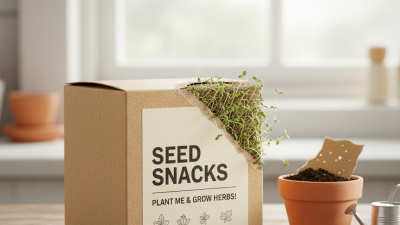
The demand for sustainable packaging in the food industry has surged, with a recent report from Smithers Pira indicating that the global sustainable packaging market is expected to reach $500 billion by 2028. This trend is driven by consumers increasingly prioritizing eco-friendly practices and companies striving to reduce their environmental footprint. Innovative food packaging designs are now exploring unique materials such as bioplastics, recycled paper, and even mycelium, which not only reduce waste but also align with modern branding strategies focused on sustainability.
One prominent example is the use of plant-based materials, which are being adopted by businesses looking to minimize their reliance on fossil fuels. Companies like Nestlé have led this charge, pledging to make 100% of their packaging recyclable or reusable by 2025. Additionally, innovative designs utilizing water-soluble films and edible packaging, like those developed by companies such as WikiFoods, are gaining traction. A report from Nielsen suggests that nearly 66% of consumers are willing to pay more for sustainable brands, further illustrating that integrating unique, sustainable materials into food packaging not only meets regulatory demands but also attracts a conscious consumer base eager for environmentally responsible choices.
In the ever-evolving world of food packaging, functional design plays a crucial role in enhancing user experience. Modern businesses are increasingly focusing on creating packaging that not only protects the product but also adds convenience for the consumer. One notable trend is the use of easy-open features, which cater to today's fast-paced lifestyle, allowing customers to enjoy their food with minimal effort. Additionally, incorporating multi-use packaging can significantly elevate user satisfaction by offering reusable options that promote sustainability.
Tips: When designing packaging, consider the end-user's needs. Aim for intuitive designs that facilitate ease of use. For example, packaging that can double as a serving dish not only saves space but also enhances the overall dining experience. Furthermore, integrating clear information about product usage and recyclability can greatly attract conscious consumers looking for practical options.
Another innovative approach is the inclusion of interactive elements in packaging. QR codes linking to recipes or product stories can engage consumers further, turning a simple package into an ongoing conversation. This strategy not only builds brand loyalty but also creates a memorable experience that keeps customers coming back for more. Packaging that tells a story resonates well, fostering a deeper connection between the product and the customer.
In today's competitive food industry, visual appeal plays a crucial role in packaging design. Eye-catching aesthetics not only draw the attention of potential customers but also communicate the brand’s identity and values. The packaging acts as a silent salesperson, making an immediate impression that can influence purchasing decisions. Innovative designs that blend vibrant colors, unique shapes, and engaging graphics can evoke emotions, spark curiosity, and ultimately entice consumers to choose one product over another.
Moreover, effective food packaging goes beyond just looks; it also needs to convey practical information such as freshness, quality, and sustainability. For example, designs that incorporate transparent elements can showcase the product inside, allowing consumers to visually assess its quality. Packaging that tells a story or reflects the brand's ethos can create a strong connection with the audience.
As modern businesses strive to stand out in a crowded market, investing in visually appealing packaging becomes a strategic move to enhance brand recognition and customer loyalty.
In the evolving landscape of the food industry, technological integration in packaging plays a pivotal role in enhancing both freshness and safety. As per a report by Grand View Research, the global smart packaging market is projected to reach $46.6 billion by 2027, growing at a compound annual growth rate (CAGR) of 7.4%. This growth is attributed to the increasing consumer demand for fresh, safe, and high-quality food products. Innovations such as temperature-sensitive labels and time-temperature indicators are becoming mainstream, providing real-time data on product conditions, thereby minimizing food waste and ensuring optimal shelf life.
Moreover, smart packaging solutions often employ advanced materials and technologies, including nanotechnology and biodegradable substances, which not only preserve product integrity but also cater to the rise of eco-conscious consumers. According to a survey conducted by Nielsen, 66% of global respondents are willing to pay more for sustainable brands, showcasing the demand for environmentally friendly packaging options. As businesses continue to embrace these cutting-edge packaging solutions, they are not only enhancing their product offerings but also fostering a commitment to safety and sustainability in the food supply chain.
In the competitive landscape of modern business, packaging plays a crucial role in establishing
brand identity and meeting consumer needs. Customizable food packaging
solutions allow brands to reflect their unique ethos while offering practicality for consumers. By integrating
elements like color schemes, logos, and sustainable materials, businesses can create
packaging that not only stands out on the shelf but also resonates with
their target audience's values and preferences.
Moreover, adaptive packaging designs enhance the user experience by addressing specific requirements. For instance,
incorporating easy-open features and portion control mechanisms caters to consumer convenience, while
eco-friendly materials align with the growing demand for sustainability. This dual focus on aesthetic appeal
and functionality enables brands to connect deeply with consumers, fostering loyalty and encouraging repeat purchases.
As companies embrace innovative approaches to packaging design, the potential for
tailored solutions that enhance both brand image and customer satisfaction becomes limitless.
